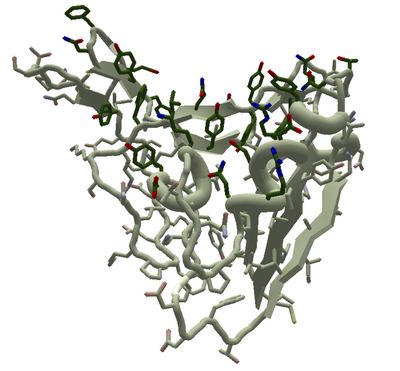
The Coronavirus Spike Protein, as seen in puzzle 1805b. The spike's binding site is along the curved "groove" at the top. The green sidechains are unlocked, and can move. (EnzDes coloring.)
Here are some questions and answers about the coronavirus puzzles in Foldit:
[]
See Puzzles on the Foldit website for the current coronavirus puzzles. There will likely be one or more coronavirus puzzles running for the foreseeable future.
It's best to complete the intro campaign before starting either the beginner or the intermediate coronavirus puzzles. See can I skip the intro campaign below if you want to take a peek at the other puzzles.
How do I play Foldit?[]
Foldit is an app that runs on Windows, Mac OS, or Linux. At the moment, a desktop or laptop is required, and the game doesn't support Chromebooks or mobile devices.
You download the app from the official Foldit website, where you also register as a player.
See Download-Install-Troubleshoot for tips on getting started.
Once you have the Foldit app installed, you'll be asked to play a series of Intro Puzzles to get familiar with how the game works. Once you complete the intro puzzles (also known as the "campaign level"), you can play the science puzzles, such as the coronavirus puzzle.
[]
Yes, but it's not recommended. If you want to peek, Menu -> Puzzle Menu -> Main Menu -> Science Puzzles. (Control-P makes the shortcut a little shorter.)
There will likely at least one intermediate level coronavirus puzzle running.
What's the point? Can't computers/AI do this?[]
Computers are getting better at some parts of protein folding, especially the "structure prediction" part. Structure prediction is taking a chain of amino acids and predicting its final folded shape. Foldit has recently been emphasizing other aspects of protein folding, such as protein design, where the bots are still lagging behind puny humans. The coronavirus puzzle is a specific type of design puzzle, known as a binder puzzle.
If you want to share computing power with the protein bots, there's Foldit's sibling Rosetta@Home and also Folding@Home.
[]
The Foldit coronavirus puzzles are not about finding the structure of the COVID-19 coronavirus, which has been designated SARS-CoV-2. Scientists were quickly able to figure out the structure of the "spike protein" that SARS-CoV-2 uses to attach to human cells, using known coronavirus spikes as a guide.
The Foldit puzzle includes a small section of the SARS-CoV-2 spike protein, and invites players to design a protein that binds to the spike. The designable part becomes a "binder", so this is a binder puzzle.
A binder that binds well could be a first step toward limiting COVID-19 infections, but a lot more steps would be needed to create something that actually works.
See Coronavirus Spike Protein for the technical details about the SARS-CoV-2 spike target as it appears in the Foldit puzzle.
What happens to my design?[]
In any Foldit puzzle, the goal is to produce a high-scoring solution. For the coronavirus puzzle, the designed binder part should fit the coronavirus spike target closely, particularly the areas that have moveable sidechains.
A good design could eventually become the basis on an antiviral drug or a vaccine.
A good design is just the first step in the process, however. The Foldit science team looks at top-scoring designs and anything shared using "Share With Scientists" for each design puzzle.
Promising designs get automated testing, including through Rosetta@Home. Designs that hold up then go into the "wet lab", which involves ordering synthetic DNA and using E. coli to grow the proteins in the lab.
After the bacteria do their thing, the protein must be extracted and purified. Various tests at this stage show whether the protein in fact folded up.
For a successfully folded protein, the next step is usually growing crystals, for X-ray crystallography experiments. Cryo electron microscopy is also an option, a less precise alternative to X-rays that doesn't require crystals.
If a design survives all these steps, the result is a 3D structure of a protein that can be compared to the original design.
The blog post Coronavirus designs queued for testing! describes how player designs will be tested.
If a design ultimately passes all the tests, it becomes a solved Foldit design, and is most likely discussed in a scientific paper at some point. The 3D structure of the protein will most likely be added to the Protein Data Bank (PDB). Foldit players who work on a successful design will be credited as authors on any papers or PDB depositions.
Only four proteins designed by Foldit players in earlier puzzles are known to have passed all these challenges and made it into the PDB. There may be other solved designs in the pipeline, but they haven't been published yet.
In addition to the named authors (using real names), many more players have been cited as contributors using their Foldit screen names. Not bad to see your user name in Science.